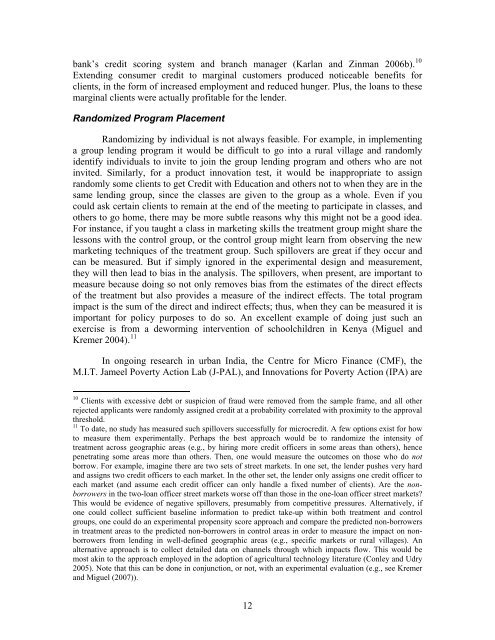Impact Evaluation for Microfinance: Review of Methodological Issues
Impact Evaluation for Microfinance: Review of Methodological Issues
Impact Evaluation for Microfinance: Review of Methodological Issues
You also want an ePaper? Increase the reach of your titles
YUMPU automatically turns print PDFs into web optimized ePapers that Google loves.
ank’s credit scoring system and branch manager (Karlan and Zinman 2006b). 10<br />
Extending consumer credit to marginal customers produced noticeable benefits <strong>for</strong><br />
clients, in the <strong>for</strong>m <strong>of</strong> increased employment and reduced hunger. Plus, the loans to these<br />
marginal clients were actually pr<strong>of</strong>itable <strong>for</strong> the lender.<br />
Randomized Program Placement<br />
Randomizing by individual is not always feasible. For example, in implementing<br />
a group lending program it would be difficult to go into a rural village and randomly<br />
identify individuals to invite to join the group lending program and others who are not<br />
invited. Similarly, <strong>for</strong> a product innovation test, it would be inappropriate to assign<br />
randomly some clients to get Credit with Education and others not to when they are in the<br />
same lending group, since the classes are given to the group as a whole. Even if you<br />
could ask certain clients to remain at the end <strong>of</strong> the meeting to participate in classes, and<br />
others to go home, there may be more subtle reasons why this might not be a good idea.<br />
For instance, if you taught a class in marketing skills the treatment group might share the<br />
lessons with the control group, or the control group might learn from observing the new<br />
marketing techniques <strong>of</strong> the treatment group. Such spillovers are great if they occur and<br />
can be measured. But if simply ignored in the experimental design and measurement,<br />
they will then lead to bias in the analysis. The spillovers, when present, are important to<br />
measure because doing so not only removes bias from the estimates <strong>of</strong> the direct effects<br />
<strong>of</strong> the treatment but also provides a measure <strong>of</strong> the indirect effects. The total program<br />
impact is the sum <strong>of</strong> the direct and indirect effects; thus, when they can be measured it is<br />
important <strong>for</strong> policy purposes to do so. An excellent example <strong>of</strong> doing just such an<br />
exercise is from a deworming intervention <strong>of</strong> schoolchildren in Kenya (Miguel and<br />
Kremer 2004). 11<br />
In ongoing research in urban India, the Centre <strong>for</strong> Micro Finance (CMF), the<br />
M.I.T. Jameel Poverty Action Lab (J-PAL), and Innovations <strong>for</strong> Poverty Action (IPA) are<br />
10 Clients with excessive debt or suspicion <strong>of</strong> fraud were removed from the sample frame, and all other<br />
rejected applicants were randomly assigned credit at a probability correlated with proximity to the approval<br />
threshold.<br />
11 To date, no study has measured such spillovers successfully <strong>for</strong> microcredit. A few options exist <strong>for</strong> how<br />
to measure them experimentally. Perhaps the best approach would be to randomize the intensity <strong>of</strong><br />
treatment across geographic areas (e.g., by hiring more credit <strong>of</strong>ficers in some areas than others), hence<br />
penetrating some areas more than others. Then, one would measure the outcomes on those who do not<br />
borrow. For example, imagine there are two sets <strong>of</strong> street markets. In one set, the lender pushes very hard<br />
and assigns two credit <strong>of</strong>ficers to each market. In the other set, the lender only assigns one credit <strong>of</strong>ficer to<br />
each market (and assume each credit <strong>of</strong>ficer can only handle a fixed number <strong>of</strong> clients). Are the nonborrowers<br />
in the two-loan <strong>of</strong>ficer street markets worse <strong>of</strong>f than those in the one-loan <strong>of</strong>ficer street markets?<br />
This would be evidence <strong>of</strong> negative spillovers, presumably from competitive pressures. Alternatively, if<br />
one could collect sufficient baseline in<strong>for</strong>mation to predict take-up within both treatment and control<br />
groups, one could do an experimental propensity score approach and compare the predicted non-borrowers<br />
in treatment areas to the predicted non-borrowers in control areas in order to measure the impact on nonborrowers<br />
from lending in well-defined geographic areas (e.g., specific markets or rural villages). An<br />
alternative approach is to collect detailed data on channels through which impacts flow. This would be<br />
most akin to the approach employed in the adoption <strong>of</strong> agricultural technology literature (Conley and Udry<br />
2005). Note that this can be done in conjunction, or not, with an experimental evaluation (e.g., see Kremer<br />
and Miguel (2007)).<br />
12






